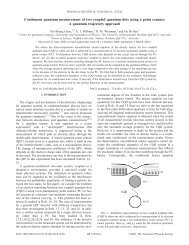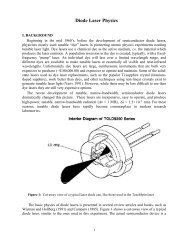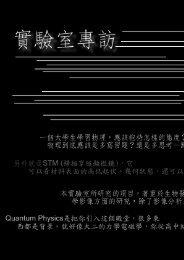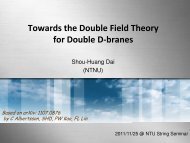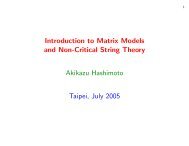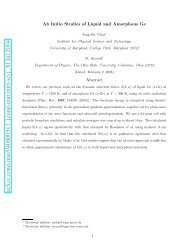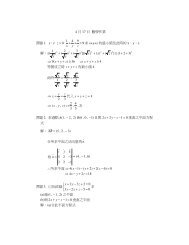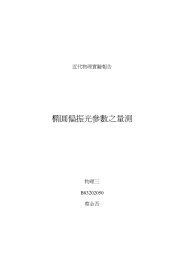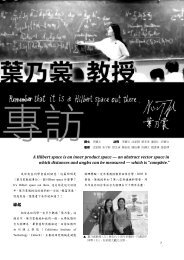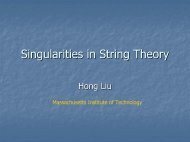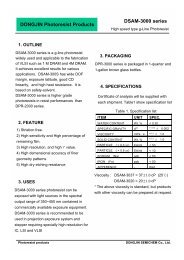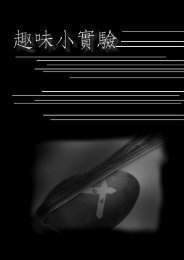semiconductors fundamentals.pdf
semiconductors fundamentals.pdf
semiconductors fundamentals.pdf
Create successful ePaper yourself
Turn your PDF publications into a flip-book with our unique Google optimized e-Paper software.
Semiconductor Fundamentals<br />
• Yuan-Huei Chang
Lattice: periodical arrangement of atoms<br />
Body-centered<br />
Zinc-Blende
Periodical potential of a lattice and the electron<br />
wavefunction<br />
http://www.mtmi.vu.lt/pfk/funkc_dariniai/quant_mech/bands.htm
• Bloch theorem<br />
• U (r)= U (r+R),<br />
R is any lattice vector<br />
• H=P 2 /2m+ U (r)<br />
• H Φ = E Φ<br />
• Φ k (r)= = e ik·r u (r)<br />
• u (r) = u (r+R)<br />
• k could be used to specify the electronic<br />
state and p=ћk, is the crystal momentum of<br />
the electron in the lattice
From energy level to<br />
energy band<br />
○<br />
○<br />
△E<br />
○<br />
○<br />
△E<br />
○<br />
○
Relation between width of the energy<br />
band and the inter-atomic distance<br />
△E<br />
d
Band structure of solid<br />
Conduction<br />
band<br />
E F : Fermi evel<br />
Energy gap<br />
Valence<br />
band<br />
insulator<br />
metal
What is a hole<br />
The collective motion of n-1 electrons.<br />
When a filled band has holes, it can<br />
conduct electricity.<br />
Net effect<br />
missing<br />
電 洞<br />
Sum=0
E-k relation for an electron in a lattice<br />
• For an electron in the vacuum E = ћ 2 k 2 /2m.<br />
• In a lattice E(k) is usually a very complicated function<br />
http://zh.wikipedia.org/wiki/%E5%8D%8A%E5%AF%BC%E4%BD%93
E- k and v-k relation for an electron<br />
in a lattice<br />
•<br />
A filled band does not conduct
有 效 質 量 (effective mass)<br />
• In vacuum E = ћ 2 k 2 /2m and m is independent of E.<br />
• In a lattice E=E(k).<br />
• E(k)= ћω(k), and v g =dω/dk /dk v g =(1/ ћ) dE/dk<br />
• a=d v g /dt=(1/ ћ) d 2 E/dkdt=(1/ ћ) d 2 E/dk 2 (dk/dt)<br />
• p= ћk, F=dp/dt= ћ dk/dt dk/dt= (1/ ћ) F<br />
• a=(1/ ћ 2 )F d 2 E/dk 2<br />
• m* - 1 = (1/ ћ 2 ) d 2 E/dk 2<br />
• m*<br />
-1 ij = (1/ ћ 2 ) ∂ 2 E/ ∂k i ∂k j
<strong>semiconductors</strong><br />
1. Intrinsic semiconductor is an insulator<br />
2. The conduction property of the SC is<br />
determined by the impurity in the SC.<br />
3. Whether a semiconductor is useful depends<br />
on<br />
a. Low defect density pure substrate could<br />
be obtained.<br />
b. Controlled doping of n and p type<br />
impurities can be achieved
Donor and acceptor<br />
http://www.physics.udel.edu/~watson/scen103/colloq2000/doping-donor.html
Binding energy of donor and acceptor


